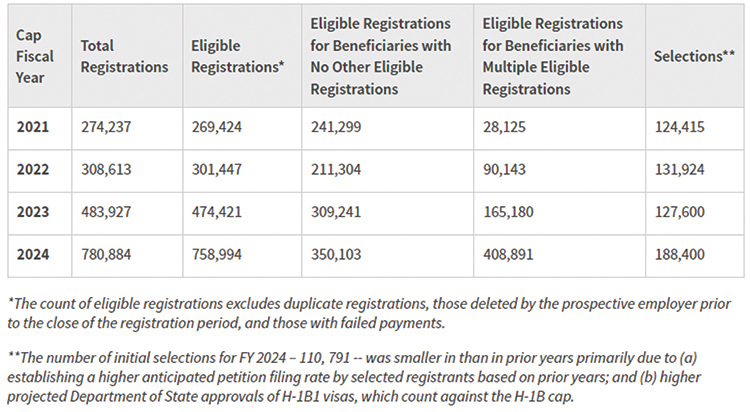
On January 30, 2024, USCIS (U.S. Citizenship and Immigration Services) issued a Final Public Notice raising filing fees for many applications and petitions submitted requesting immigration benefits in the United States. The fee increase reflects a multi-year effort by USCIS to address cost increases that the agency has faced over the years.
As a fee-driven agency, USCIS is almost entirely reliant upon filing fees to cover costs associated with document processing and adjudications. USCIS last changed filing fees in 2016 and as such, the new fee schedule has been expected for years.
The new fee schedule will be active as of April 1, 2024, and reflect an approximate 26 percent increase for most submissions. Most fees do not increase too dramatically (i.e. the cost of naturalization filings increases from $725 to $760), although green card submissions now require additional fees for employment authorization and travel document filings, which were previously included in the adjustment of status filing fee. Fee discounts will also be available for nonprofits and small employers, as well as reductions for certain filings for individuals under the age of 14.
The most significant change will likely be felt by employers seeking nonimmigrant visas for their workers, with H-1B, L-1 and O-1 filings each seeing a dramatic increase in base fees for the application and the addition of new costs. The base fee for all three filings is currently $460, but after April 1, fees for these filings will rise depending upon the number of full-time employees an employer has.
Employers with 25 or fewer will have lower costs, whereas employers with 26 or more employees will have higher fees. For example, H-1Bs will rise to $460 for small employers – $780 for large employers; L-1s will increase to either $695 or $1385; O-1s will jump to from $530 to $1055, again depending on the size of the employer.
Employers will also be required to submit an additional $600 as an Asylum Program Fee (only $300 for small employers and nonprofits), which is designed to help the agency displace the costs associated with asylum filings, as USCIS is prohibited by statute for charging for asylum filings. H-1B registration, which opens in mid-March will continue to have a $10 registration fee, although that will rise to $215 in 2025. By separate notice, USCIS has also raised the cost of Premium Processing (15 business day adjudications) from $2500 to $2805.
Part of the fee increases also focused on moving USCIS towards a paperless adjudications process, with the agency lowering the cost of naturalization, certain visa petitions and work permit applications submitted through its ELIS online portal. ELIS filings do not extend to all immigration applications and the system has been mired with technical glitches, security issues and outages during its existence, but USCIS’ willingness to incentivize online filings through lowered filing fees focuses the agency’s intention of reducing the environmental impact of paper filings, while simultaneously seeking to expedite adjudications.
Changes to H-1B Registration Process
The fee increases were not the only changes felt in the immigration field, as USCIS announced changes to the H-1B registration process aimed at reducing fraud and gamesmanship in the H-1B selection process. Because the number of new H-1B visas are capped annually (65,000 regular cap with an additional 20,000 Masters cap applicants), USCIS has utilized a lottery process for determining who would be selected to submit an application.
Prior to 2021, USCIS required that applicants construct an entire H-1B filing (usually 100+ pages of documentation) to register for the cap lottery, but in 2021, USCIS changed the system to an online registration, thus reducing the amount of documentation received by the agency and also the cost on employers (alas, lawyers were the big losers with the change).
The result was a system that was much more streamlined and efficient and permitted a single individual to be entered into the lottery as many times as they wanted, provided that a single employer did not register the same individual more than once. What resulted was a bonanza of registrations with reports showing a single individual being registered by multiple employers that magnified over time.
As shown in the chart below, in 2021 the total number of registrations was 274,424 with only about 10 percent of applicants being registered by multiple employers; by 2024, that number of registrations had almost tripled with the number of multiple registrations now constituting over 50 percent of all registrations.

USCIS’ new rule, which is effective immediately changes the registration from an employer-based selection process to an employee-based selection process, meaning that a single individual may have as many employers register him/her for the H-1B lottery as they want, but that registrations will be selected by unique beneficiary rather than by registration.
This new selection method aims to reduce gamesmanship and fraud in the registration process and caused concerns that applicants and employers were unfairly using the selection process to increase their overall chances of selection.
The new methodology reduces any incentive to have an employee submit multiple registrations from faux employers, as doing so will have no discernable impact on their individual likelihood of selection. The new rule will also codify USCIS’ ability to “deny or revoke H-1B petitions where the underlying registration contained a false attestation or was otherwise invalid.â€
The H-1B registration fee will remain $10 and the registration period will open at 12pm EST on March 6, 2024 and run through 12pm EST on March 22, 2024.
Rishi P. Oza is Partner at Brown Immigration Law, a firm that focuses solely on immigration law; he practices in Durham. roza@rbrownllc.com



